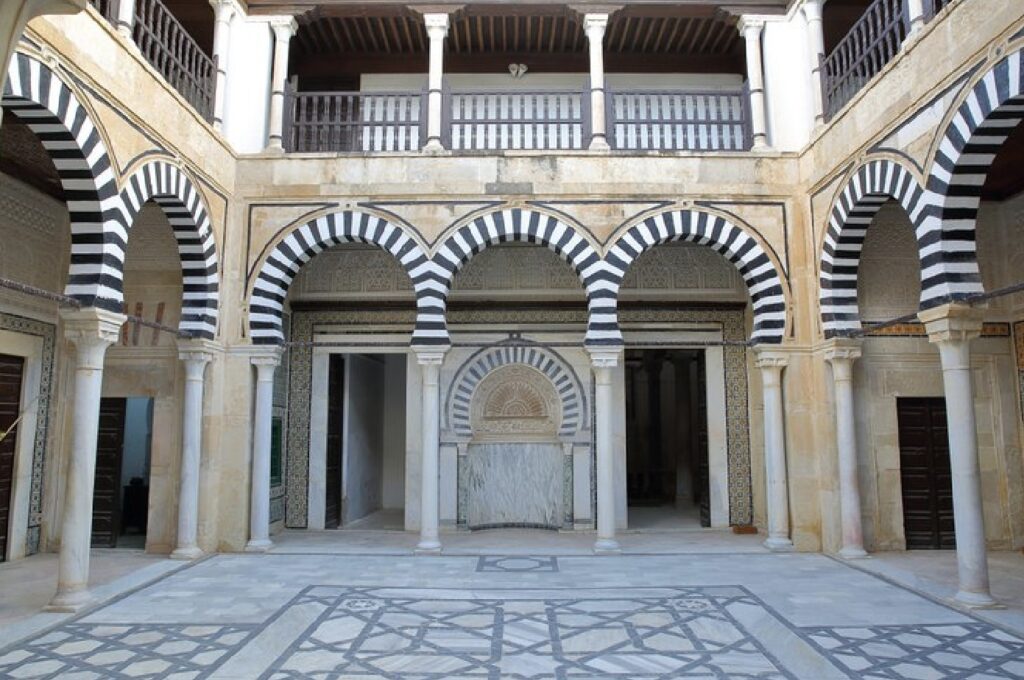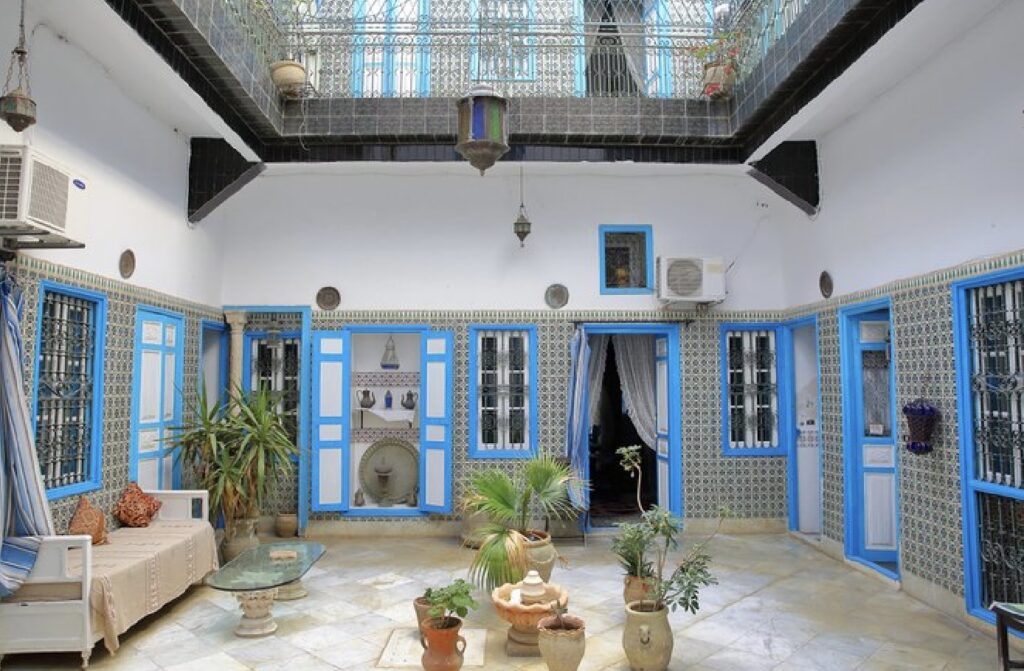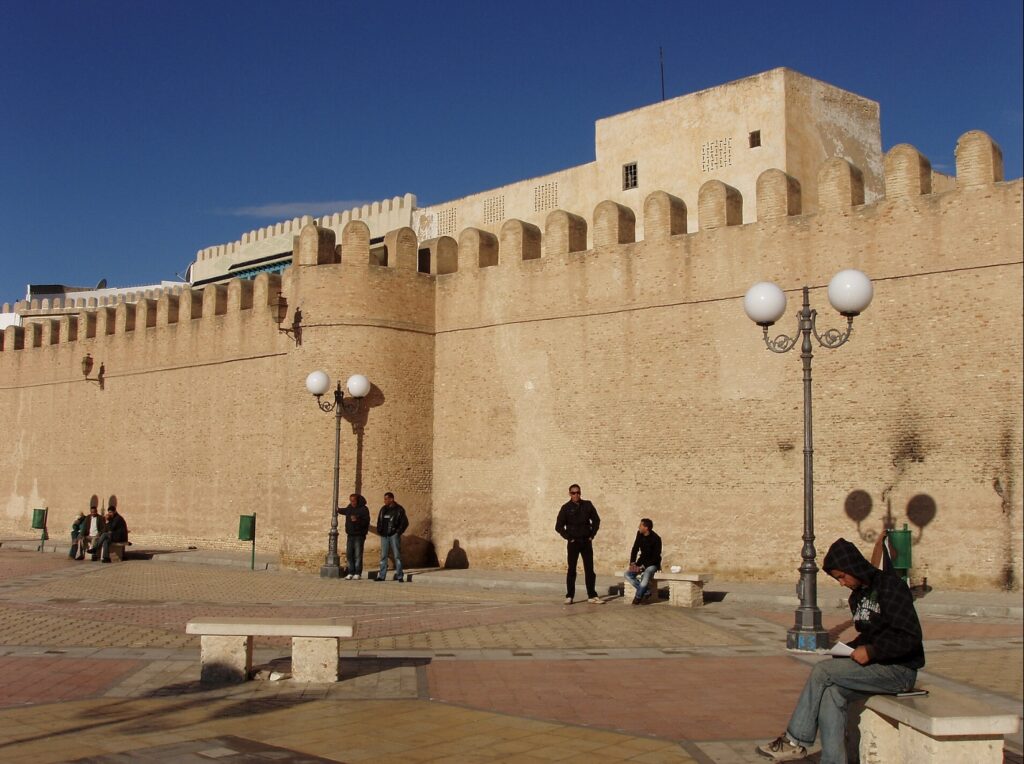ChatGPT:Kairouan, located in Tunisia, is one of the most significant and historic cities in the Islamic world. Founded in 670 AD by the Arab general Uqba ibn Nafi, it is considered the fourth holiest city in Islam and a major pilgrimage site. Kairouan is renowned for its impressive Islamic architecture, including the Great Mosque of Kairouan, also known as the Mosque of Uqba, which is one of the oldest and most important mosques in the Muslim world. The city features a labyrinth of narrow streets, traditional markets (souks), and beautifully preserved houses adorned with intricate tile work and wooden carvings. Kairouan’s rich history, cultural heritage, and religious significance make it a UNESCO World Heritage Site and a fascinating destination for visitors interested in history and Islamic culture.

Kairouan’s history and development are deeply intertwined with the early Islamic conquests and the spread of Islam in North Africa. Here’s a detailed overview of its historical development:
Early History and Founding
- 670 AD: Kairouan was founded by the Arab general Uqba ibn Nafi during the Umayyad Caliphate. It served as a military base and a hub for the spread of Islam in North Africa.
- Strategic Location: Kairouan was strategically located inland to avoid attacks from the coast and served as a base for further Islamic conquests.
Development and Growth
- 8th-9th Centuries: Under the Aghlabid dynasty, Kairouan experienced significant growth. The Aghlabids ruled from 800 to 909 AD, and during this period, Kairouan became a center of Islamic learning and culture.
- Great Mosque of Kairouan: The Great Mosque, built initially in the 7th century, was significantly expanded and enhanced during this period. It became a major center for religious scholarship and education.
- Infrastructure: The Aghlabids developed the city’s infrastructure, including the construction of aqueducts, reservoirs, and public buildings.
Cultural and Religious Significance
- Scholarly Center: Kairouan became a renowned center of Islamic scholarship, attracting scholars, theologians, and jurists from across the Islamic world. The city’s schools and libraries were well-regarded, and it became a major center for the study of Islamic law (fiqh).
- Religious Importance: As one of the holiest cities in Islam, Kairouan became a pilgrimage site. The city’s religious significance is partly due to the presence of the Great Mosque and other important religious sites.
Decline and Revival
- 10th Century: The decline began with the rise of the Fatimids, who moved their capital to Mahdia and later to Cairo. This led to a reduction in Kairouan’s political importance.
- 11th-12th Centuries: The city faced further decline due to invasions and internal conflicts, particularly during the Hilalian invasions, which caused significant destruction and depopulation.
Modern Era
- French Protectorate: During the French colonial period (1881-1956), Kairouan retained its cultural and religious significance but did not play a major political role.
- Post-Independence: After Tunisia gained independence in 1956, Kairouan continued to be an important cultural and religious center. Efforts were made to preserve its historical sites and promote tourism.
Contemporary Kairouan
- UNESCO World Heritage Site: In 1988, Kairouan was designated a UNESCO World Heritage Site, recognizing its historical, cultural, and architectural significance.
- Tourism and Preservation: Today, Kairouan is a major tourist destination, attracting visitors interested in its rich history, architecture, and religious heritage. Preservation efforts continue to maintain its historical sites and promote its cultural legacy.
- Its development over the centuries reflects the broader historical trends and transformations in North Africa and the Islamic world.
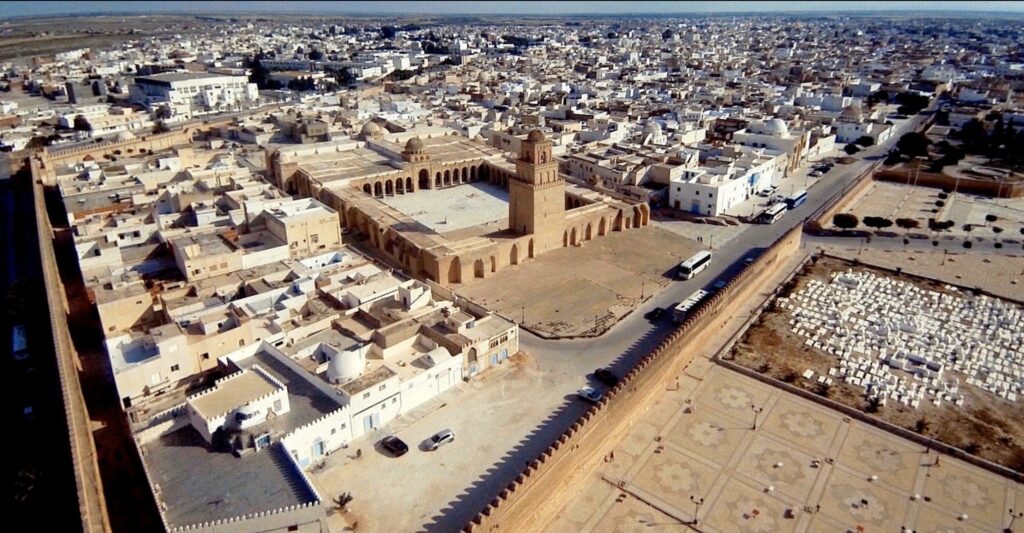
Kairouan is home to several historical monuments that reflect its rich Islamic heritage and architectural splendor. Here are some of the most notable monuments in detail:
1. Great Mosque of Kairouan (Mosque of Uqba)
- History: Originally founded by Uqba ibn Nafi in 670 AD, the mosque was significantly expanded in the 9th century under the Aghlabid dynasty.
- Architecture: The mosque features a massive courtyard, a hypostyle prayer hall with numerous columns, a large minaret, and a series of beautifully decorated mihrabs (prayer niches). The Great Mosque is renowned for its impressive and harmonious proportions, as well as its use of spolia (reused ancient Roman and Byzantine materials).
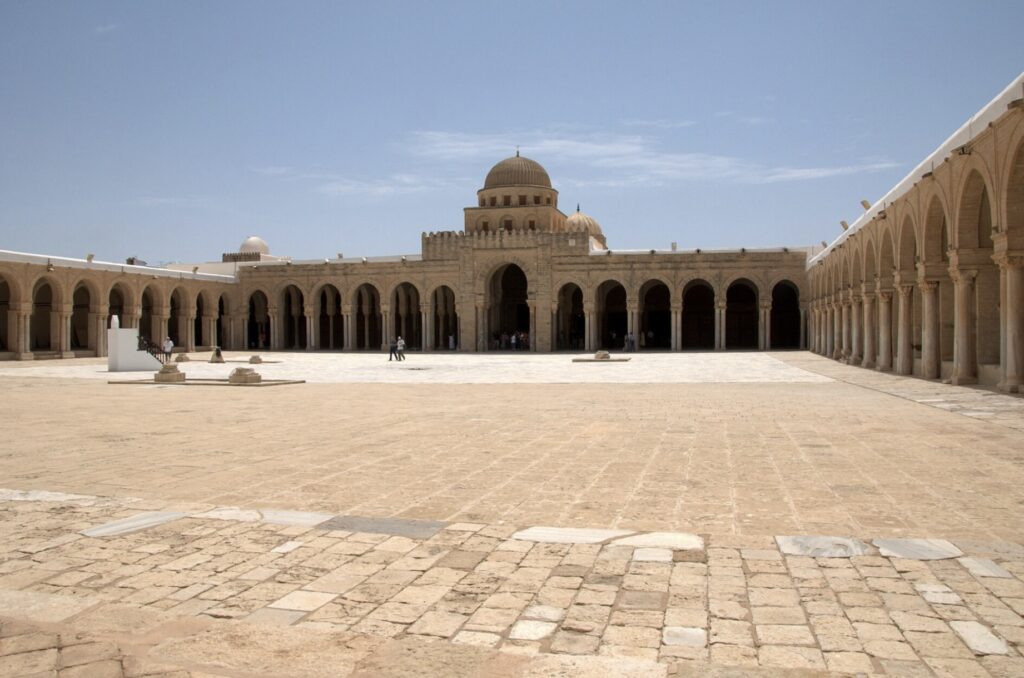
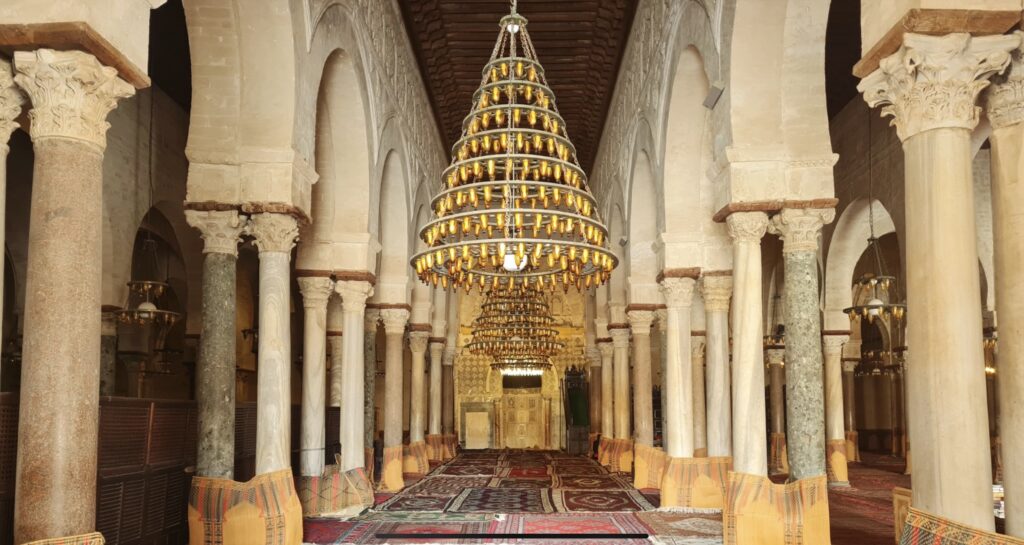
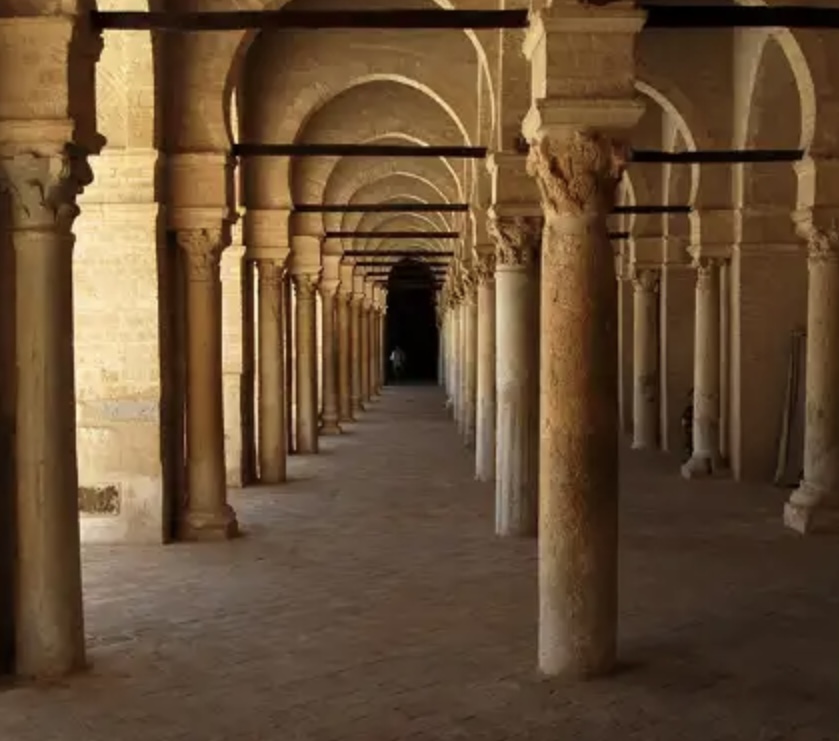
2. Mosque of the Three Gates (Mosque of Muhammad ibn Khairun)
- History: Built in 866 AD by Muhammad ibn Khairun, the mosque is known for its unique facade with three arches.
- Architecture: The facade features intricate Kufic inscriptions and decorative patterns. The interior is relatively simple, emphasizing the contrast with the ornate exterior.
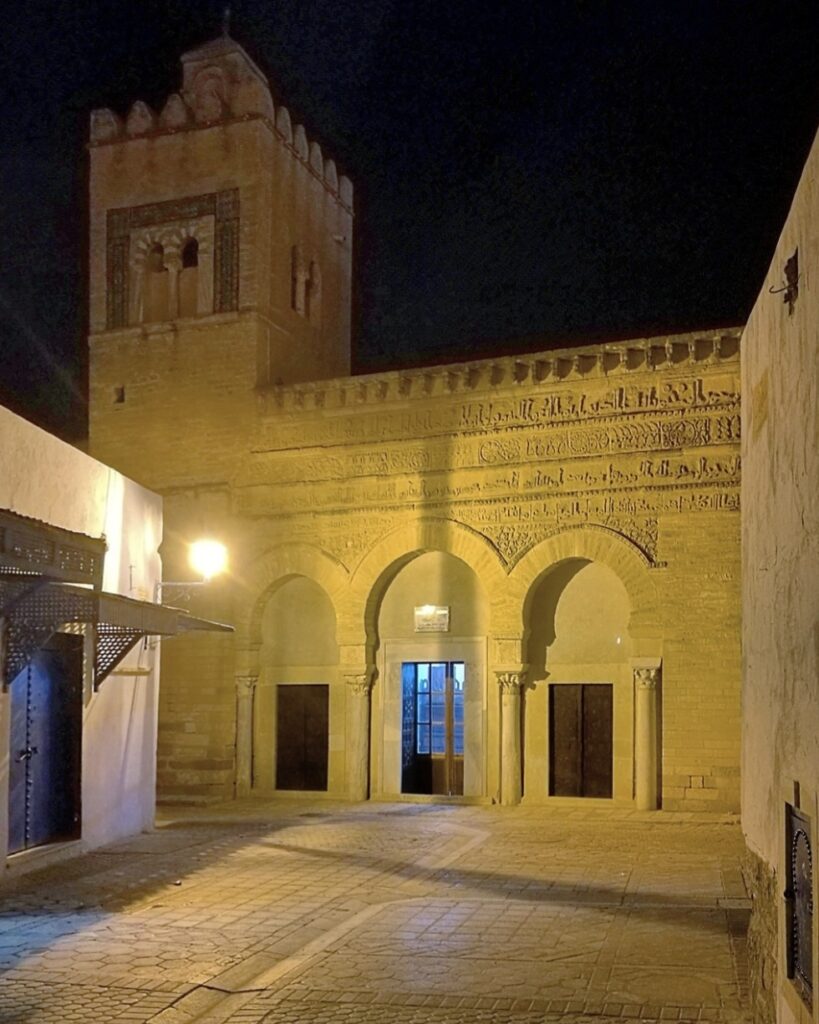
3. Aghlabid Basins (Reservoirs)
- History: Constructed in the 9th century under the Aghlabid dynasty to supply water to the city.
- Structure: The basins consist of a large circular reservoir and a smaller settling basin. They are an impressive feat of medieval engineering and demonstrate the Aghlabids’ advanced knowledge of hydraulics.
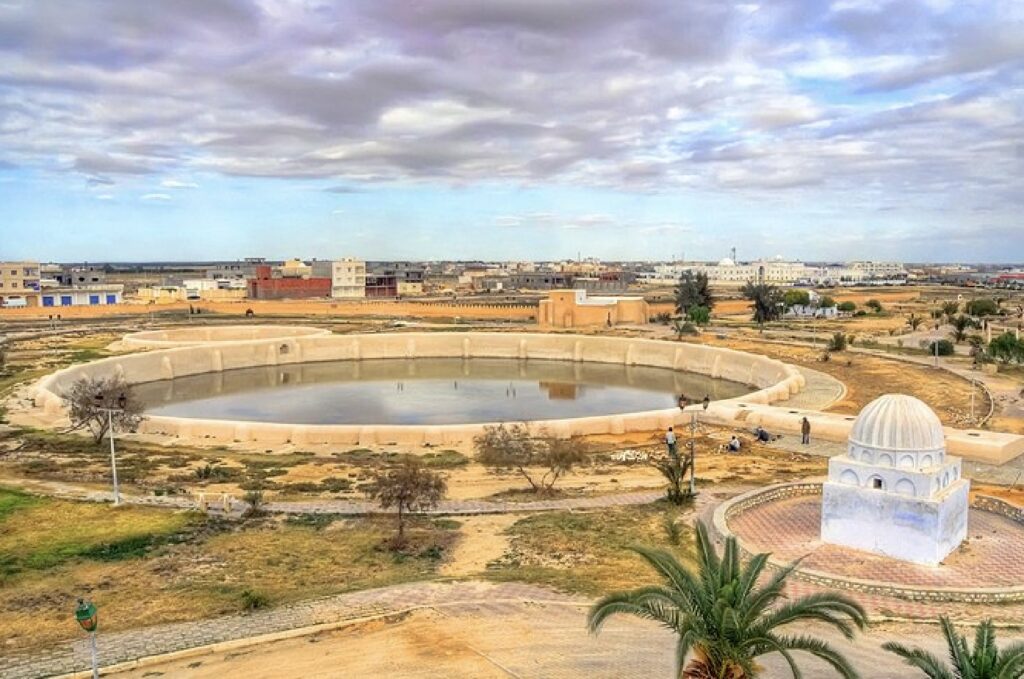
4. Barber Mosque (Zawiya of Sidi Sahab)
- History: This mosque and mausoleum complex is dedicated to Sidi Sahab, a companion of the Prophet Muhammad who is said to have carried a few hairs from the Prophet’s beard (hence the name “Barber”).
- Architecture: The complex includes a mosque, a mausoleum, and a madrasa (Islamic school). It is famous for its beautiful tile work, stucco decoration, and a tranquil courtyard.
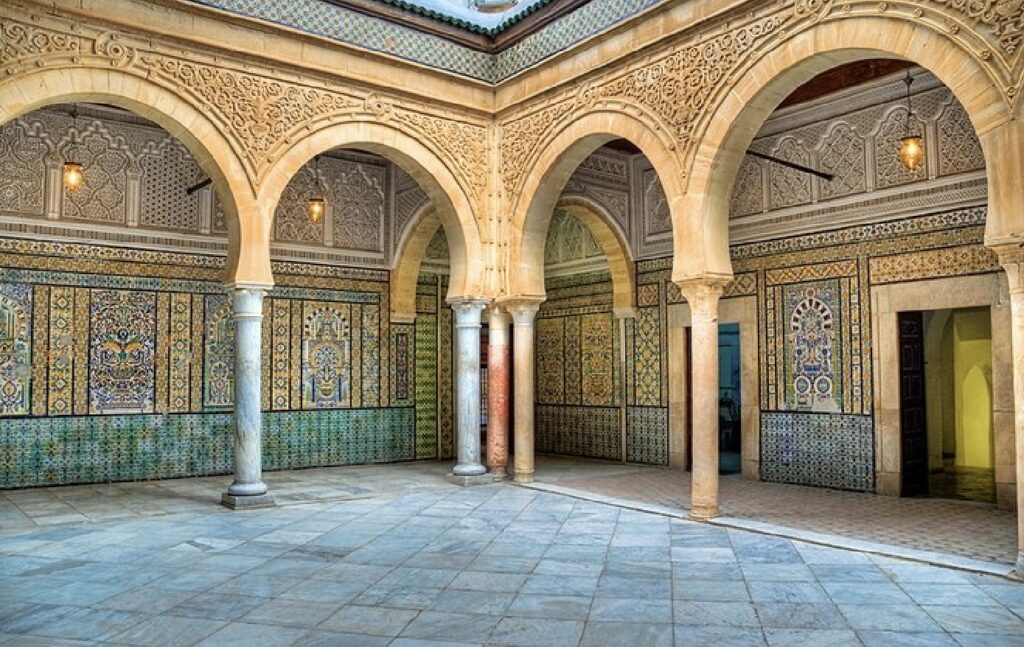
5. Zaouia of Sidi Abid al-Ghariani
- History: A religious complex that includes a mosque, a madrasa, and the tomb of Sidi Abid al-Ghariani, a prominent religious figure.
- Architecture: The site is known for its beautiful tile work, carved wood ceilings, and a serene courtyard. The zaouia serves as a place of worship and religious learning.
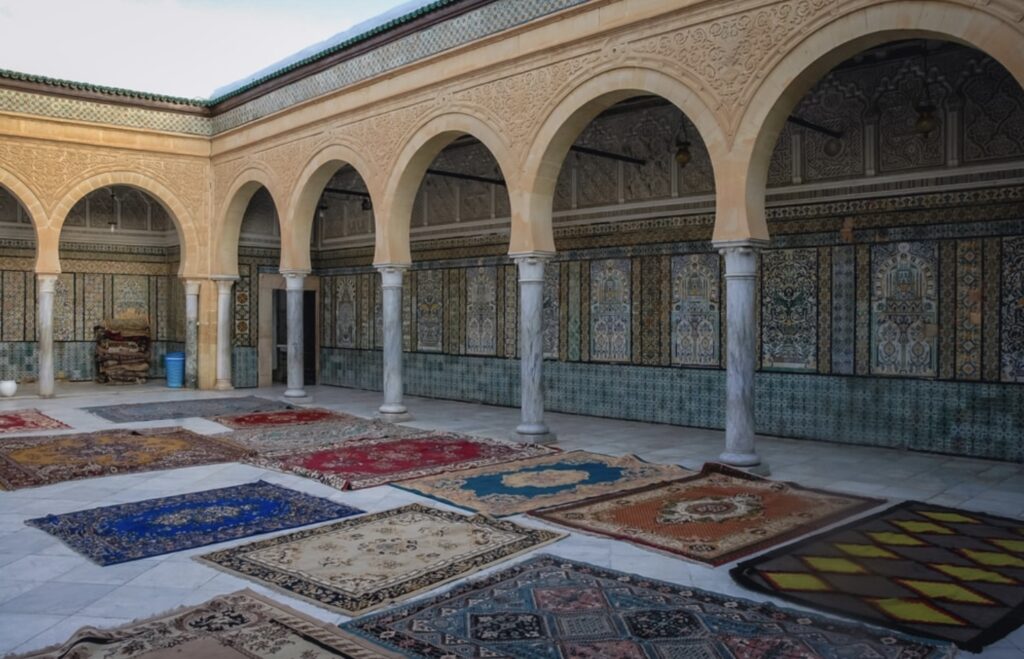
6. Medina of Kairouan
- History: The old city (medina) of Kairouan dates back to the 7th century and has been continuously inhabited since.
- Structure: The medina is a labyrinth of narrow streets, traditional houses, and bustling souks (markets). It is surrounded by ancient walls and gates, preserving its historic character.
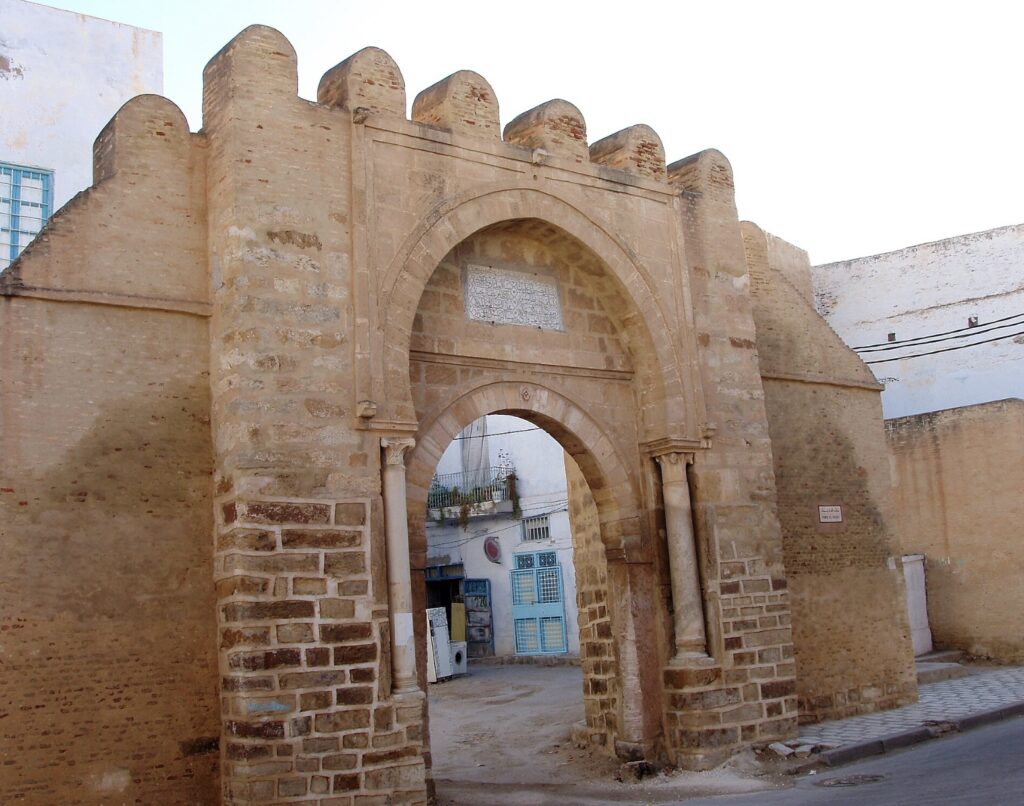
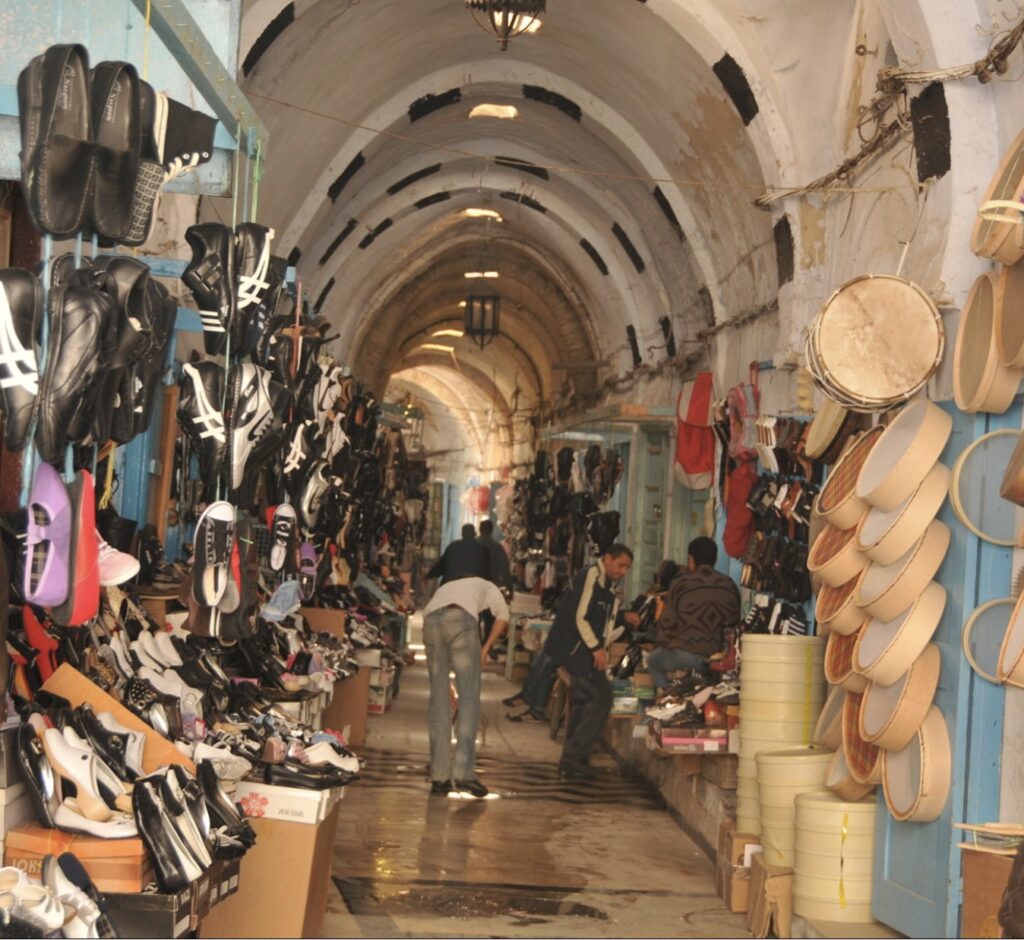
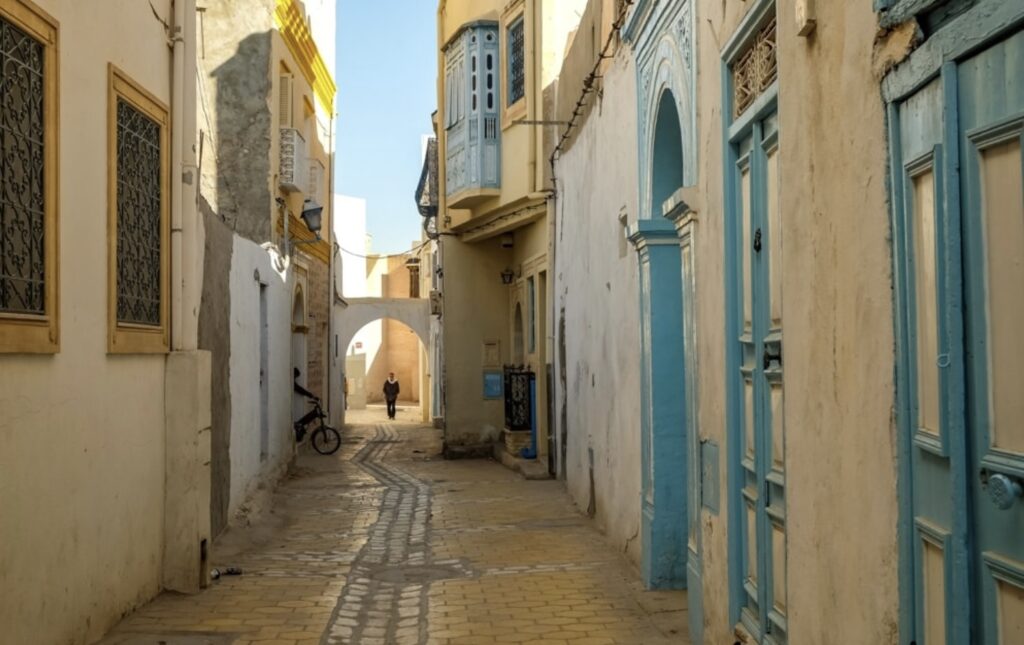
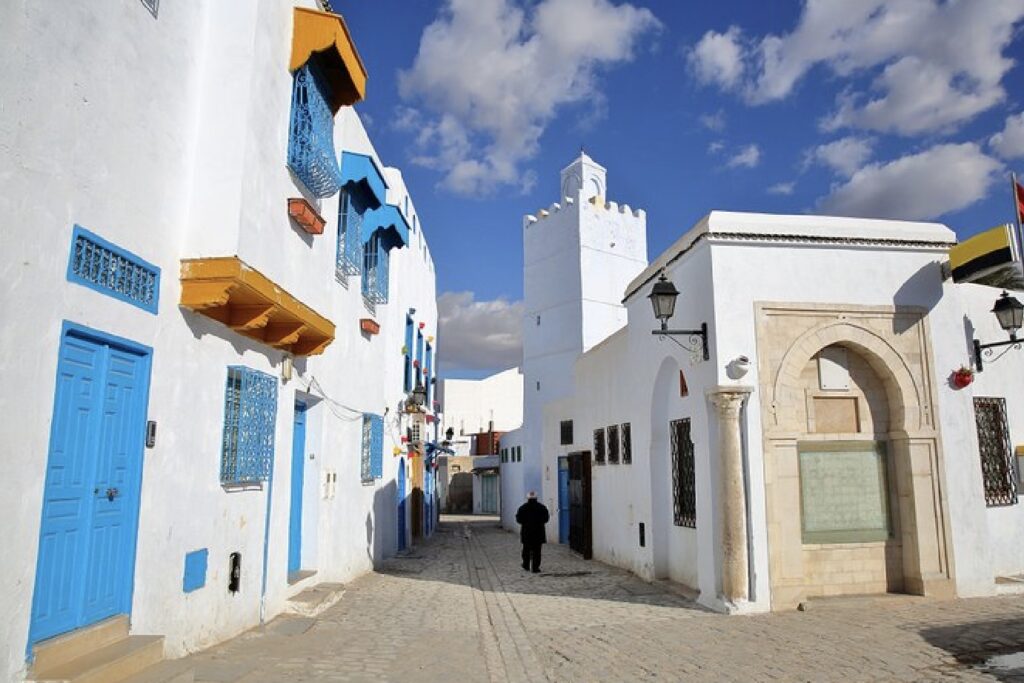
7. Aghlabid Palace Ruins
- History: The ruins of the Aghlabid palaces, which were once the seat of the Aghlabid rulers in the 9th century.
- Structure: While much of the palaces has not survived, the remains offer a glimpse into the grandeur of the Aghlabid era, with remnants of large halls, courtyards, and decorative elements.
8. Sidi Amor Abbada (The Mosque of the Sabres)
- History: Built in the 19th century, it is dedicated to the blacksmith Sidi Amor Abbada.
- Architecture: The mosque is known for its unique minaret topped with a collection of iron sabres and its spacious prayer hall. It serves as a shrine and a symbol of Sidi Amor Abbada’s legendary strength.
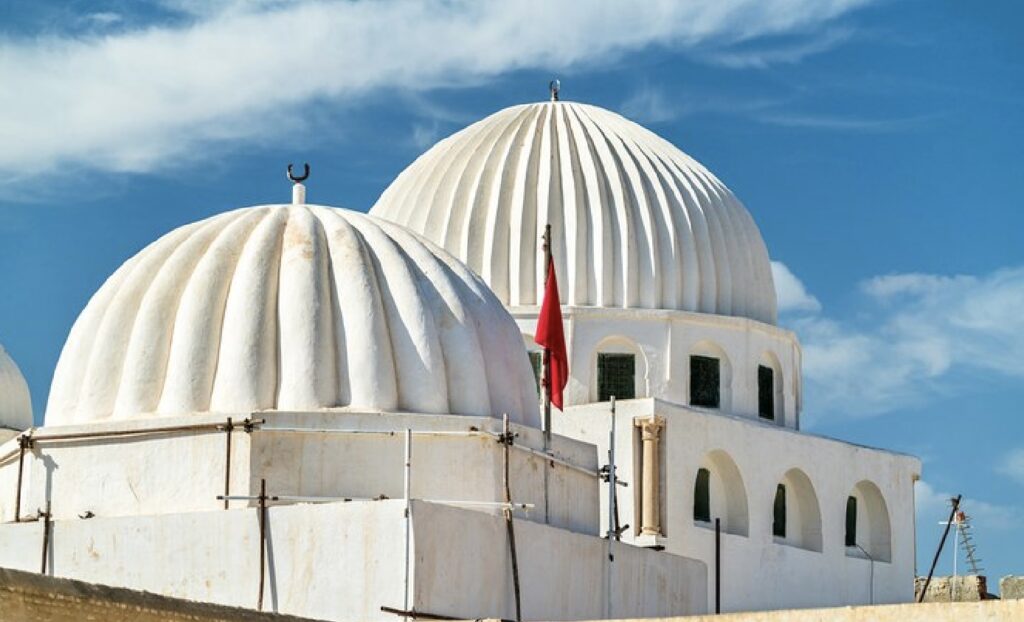
These monuments highlight Kairouan’s significance as a center of Islamic culture, education, and architecture.
In addition to its historic monuments, Kairouan offers several other tourist attractions that highlight its cultural and artisanal heritage. Here are some additional attractions worth exploring:
1.Bir Barouta
- History: An ancient well located in the heart of the medina, believed to be connected to the holy well of Zamzam in Mecca.
- Experience: Visitors can see the well and its ornate waterwheel, which is traditionally operated by a camel. The well has significant religious importance and is considered a blessed site.
2. Kairouan Carpet Shops
- Overview: Kairouan is renowned for its high-quality handwoven carpets, which are an important part of the city’s artisanal tradition.
- Experience: Tourists can visit various carpet shops and workshops within the medina to observe the weaving process and purchase authentic Kairouan carpets.
3. National Museum of Islamic Art
- Location: Situated within the Raqqada Palace, a few kilometers outside Kairouan.
- Collections: The museum houses an extensive collection of Islamic art, including manuscripts, ceramics, textiles, and coins from the early Islamic period to the Ottoman era. It provides insights into the rich artistic heritage of Kairouan and the broader Islamic world.
4.Aghlabid Basin Park
- Overview: A park area surrounding the historic Aghlabid Basins.
- Experience: Visitors can stroll through the park, enjoying the view of the ancient reservoirs and learning about the Aghlabids’ advanced water management system. The park offers a peaceful environment for relaxation and reflection.
5. Local Cuisine and Restaurants
- Overview: Kairouan offers a variety of traditional Tunisian cuisine.
- Experience: Tourists can enjoy local dishes such as couscous, brik (a type of pastry), and mechouia salad at local restaurants and cafes. Traditional sweets like makroudh, a date-filled pastry, are a must-try.
6.Craft Workshops and Artisanal Shops
- Overview: Kairouan is known for its traditional crafts, including pottery, leatherwork, and metalwork.
- Experience: Visitors can explore various workshops and shops where artisans create and sell their handmade goods. These crafts make for unique souvenirs and offer a glimpse into the local culture.
7.Cultural Events and Festivals
- Overview: Kairouan hosts various cultural events and festivals throughout the year.
- Experience: Visitors can attend events such as the Kairouan Festival of Arab and Islamic Music, which showcases traditional music, dance, and poetry, highlighting the city’s rich cultural heritage.
Kairouan’s diverse attractions provide a comprehensive experience of its historical, cultural, and artisanal significance.
For an architecture and history enthusiast, a one-day itinerary in Kairouan can be packed with visits to its most significant historical and architectural sites. Here’s a detailed itinerary to make the most out of a day in Kairouan:
Morning
8:00 AM – Breakfast
- Start your day with a traditional Tunisian breakfast at a local cafe. Enjoy fresh pastries, bread with olive oil, and mint tea.
9:00 AM – Great Mosque of Kairouan
- Spend the morning exploring the Great Mosque of Kairouan. Take your time to appreciate its vast courtyard, impressive minaret, and detailed interior with its forest of columns and intricate mihrab.
- Highlights: Courtyard, minaret, prayer hall, mihrab.
10:30 AM – Mosque of the Three Gates
- A short walk from the Great Mosque, visit the Mosque of the Three Gates. Admire its unique facade adorned with Kufic inscriptions and floral patterns.
- Highlights: Three-arched facade, decorative inscriptions.
11:00 AM – Medina of Kairouan
- Stroll through the medina, absorbing the atmosphere of this ancient city. Explore the narrow streets, traditional houses, and vibrant souks. You can shop for local crafts, such as carpets, pottery, and leather goods.
- Highlights: Traditional houses, souks, local crafts.
Midday
12:30 PM – Lunch
- Enjoy a traditional Tunisian lunch at a local restaurant. Try dishes like couscous, brik, and mechouia salad.
Afternoon
1:30 PM – Aghlabid Basins
- Visit the Aghlabid Basins, an impressive 9th-century water management system. Learn about the engineering marvels of the Aghlabids and enjoy a walk around the park surrounding the basins.
- Highlights: Large circular reservoir, smaller settling basin, park area.
2:30 PM – Barber Mosque (Zawiya of Sidi Sahab)
- Head to the Barber Mosque, a beautiful complex dedicated to Sidi Sahab. Explore the mosque, mausoleum, and madrasa, and appreciate the intricate tile work and serene courtyard.
- Highlights: Tile work, mausoleum, courtyard.
3:30 PM – National Museum of Islamic Art
- Travel a few kilometers outside Kairouan to visit the National Museum of Islamic Art at Raqqada. Explore the museum’s extensive collection of Islamic art, including manuscripts, ceramics, textiles, and coins.
- Highlights: Manuscripts, ceramics, textiles, coins.
Late Afternoon
4:30 PM – Zaouia of Sidi Abid al-Ghariani
- Return to Kairouan and visit the Zaouia of Sidi Abid al-Ghariani. Explore its beautiful tile work, carved wood ceilings, and tranquil courtyard.
- Highlights: Tile work, wood ceilings, courtyard.
5:30 PM – Relax with a Refreshment
- Enjoy a relaxing break at a local cafe. Have a cup of mint tea or coffee and a piece of traditional pastry like makroudh.
Evening
6:00 PM – Sunset at Bir Barouta
- End your day with a visit to Bir Barouta, the ancient well. Experience the atmosphere of this religious site and see the waterwheel operated by a camel.
- Highlights: Well, waterwheel, religious significance.
7:00 PM – Dinner
- Conclude your day with a delightful dinner at a local restaurant. Savor more Tunisian specialties and reflect on your day exploring the historical and architectural treasures of Kairouan.
This itinerary ensures you see the key historical and architectural sites of Kairouan while also experiencing the city’s unique culture and atmosphere.
